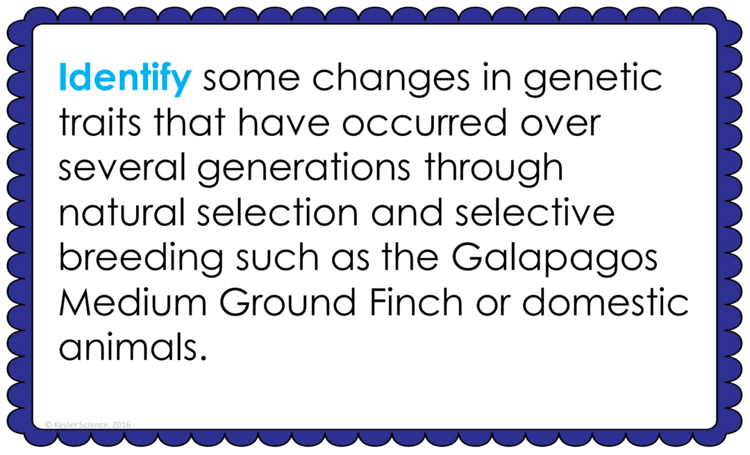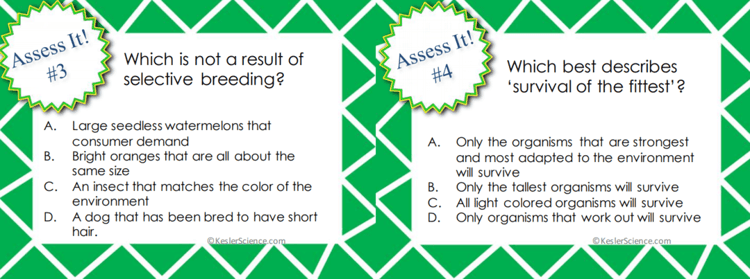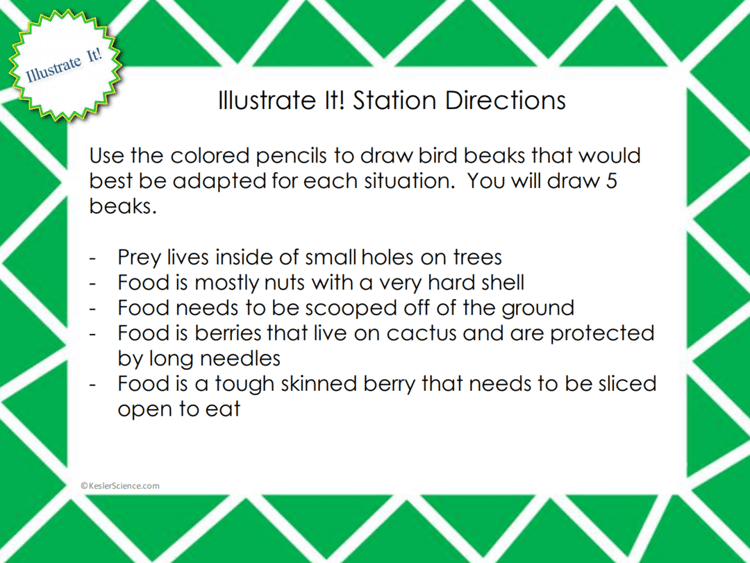NATURAL SELECTION LESSON PLAN – A COMPLETE SCIENCE LESSON USING THE 5E METHOD OF INSTRUCTION
At the end of this comprehensive natural selection lesson plan, students will be able to identify changes in genetic traits that have occurred over several generations through natural selection and selective breeding, such as the Galapagos Medium Ground Finch or domestic animals. Each lesson is designed using the 5E method of instruction to ensure maximum comprehension by the students.
The following post will walk you through each of the steps and activities from the natural selection lesson plan.
ENGAGEMENT
Objective Introduction
At the beginning of the lesson, the class will do a Think-Pair-Share to discuss the objective.
Class Activity
The teacher will ask students to write their own definition of the word adaptation, and what they already know about bird beaks and why they think that there is a wide variety of sizes and shapes.
Student Activity
Students will be assigned a number 1-4 and each number will represent a type of bird beak (plastic spoon(1), binder clip(2), forceps(3), or tweezers(4)). The teacher will then pass out a cup and some bird feed (rice, cheerios, gummy worms, macaroni, or beans). The cup will represent the bird’s stomach. Students will then predict which beak will gather the most food. The students will have 20-30 seconds to gather as much food as they can. Time allotted is determined by the amount of food the teacher prepares. Students will design a data table to record their results. Students will answer questions like; how can we summarize the data, which beak was adapted the best for each type of food, what if the birds visited a new island where only macaroni was available, what would be the outcome for the birds in future years?

The teacher will help to clear any misconceptions about natural selection. A major misconception is that students think that an adaptation is something that organisms can develop quickly.
Estimated Class Time for the Engagement: 20-30 minutes
EXPLORATION
This student-centered station lab is set up so students can begin to explore natural selection. Four of the stations are considered input stations where students are learning new information about natural selection, and four of the stations are output stations where students will be demonstrating their mastery of the input stations. Each of the stations is differentiated to challenge students using a different learning style. You can read more about how I set up the station labs here.
EXPLORE IT!
Students will be working in pairs to analyze how the peppered moths were able to camouflage before, during, and after the industrial revolution. Students will have 2 images of tree bark before/after and during the industrial revolution. Students will place the 8 moths on the before picture and see whether they were predators, and which moth could they spot first. Students will then place them on the picture of the tree during the revolution. Students will pretend that they are predators once again and see which moth is easier to see. Students will use this experience to answer a few questions about natural selection.
WATCH IT!
At this station, students will be watching a nine-minute video describing and explaining the concept of natural selection. Students will then answer questions related to the video and record their answers on their lab station sheet. For example, how can humans selectively breed a vegetable to produce a more desirable crop, what is natural selection, and finally explain how natural selection allows beetles that are camouflaged to flourish in their environment.
RESEARCH IT!
The research station will allow students to explore an interactive website to learn about actual events that occurred at Loberg Lake.
READ IT!
This station will provide students with a one page reading about natural selection and selective breeding. In the reading, students will discover what natural selection means. Students will also learn from the reading about artificial selection, and what are the advantages. There are 4 follow-up questions that the students will answer to show reading comprehension of the subject.
ASSESS IT!
The assess it station is where students will go to prove mastery over the concepts they learned in the lab. The questions are set up in a standardized format with multiple choice answers. Some questions include: identify scenarios of natural selection, which statement is incorrect about natural selection, which is not a result of selective breeding, and which best describes the phrase ‘survival of the fittest’?

WRITE IT!
Students who can answer open-ended questions about the lab truly understand the concepts that are being taught. At this station, the students will be answering three questions like explain natural selection in their own words, explain selective breeding in their own words, explain how having certain desirable traits can impact offspring or the desire to reproduce.
ILLUSTRATE IT!
Your visual students will love this station. Students will draw five bird beaks that would be best for five different scenarios, i.e. prey that lives on small holes, foods with mostly hard shells, food scooped off the ground, food in berries that grow close to a cactus stem, food that is tough and needs to be sliced to be eaten.

ORGANIZE IT!
The organize it station allows your students to place 8 cards into two categories: natural selection and selective breeding.
Estimated Class Time for the Exploration: 1-2, 45 minute class periods
EXPLANATION
The explanation activities will become much more engaging for the class once they have completed the exploration station lab. During the explanation piece, the teacher will be clearing up any misconceptions about natural selection with an interactive PowerPoint, anchor charts, and interactive notebook activities. The natural selection lesson includes a PowerPoint with activities scattered throughout to keep the students engaged.
The students will also be interacting with their journals using INB templates for natural selection. Each INB activity is designed to help students compartmentalize information for a greater understanding of the concept. The natural selection INB template allows students to focus their notes on four key concepts.
Estimated Class Time for the Exploration: 2-3, 45 minute class periods
ELABORATION
The elaboration section of the 5E method of instruction is intended to give students choice on how they can prove mastery of the concept. When students are given choice the ‘buy-in’ is much greater than when the teacher tells them the project they will have to create. Each of the natural selection projects will allow students to show their understanding of how organisms change over time and what factors cause this change.
Estimated Class Time for the Elaboration: 2-3, 45 minute class periods (can also be used as an at-home project)
EVALUATION
The final piece of the 5E model is to evaluate student comprehension. Included in every 5E lesson is a homework assignment, assessment, and modified assessment. Research has shown that homework needs to be meaningful and applicable to real-world activities in order to be effective. When possible, I like to give open-ended assessments to truly gauge the student’s comprehension.
Estimated Class Time for the Elaboration: 1, 45 minute class period
DOWNLOAD THE FULL LESSON NOW
The full lesson is available for download from the Kesler Science Store. Save yourself a ton of time and grab it now.
Download Over $100 in FREE Resources
For Middle School Science
Simply create a login below and gain immediate access to a selection of our Kesler Science product line worth $100 - for FREE. There's a full version of every product type! You'll also join tens of thousands of middle school science teachers who receive timely tips and strategies straight to their inbox.






